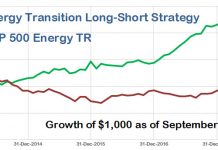Tom Konrad CFA
Past performance of green energy mutual funds.
In part I of this series, I looked at the full costs of alternative energy and climate change mutual funds. I concluded that they were quite expensive, ranging from over 2% per year, to almost 6%. In a stock market that has historically produced returns of about 10.5% per year, but has been flat for the last decade, even 2.5% in expenses per year would have resuted in a substantial loss of value. In order to make up for the drag on returns, these mutual funds will have to show strong evidence of stock picking skill.
In part II, I looked at the portfolio holdings to determine if they showed evidence of picking sectors likely to outperform, and selected the two funds I thought had the best combination of low costs and likelihood to outperform. I believe that funds that hold to many solar stocks are likely to under perform because, while solar has a bright future, today’s solar companies will probably not be the major participants.
Past Performance
While past performance, especially over just a few years, is no guarantee (or even an indication) of future results, we can still use it to check our intuition. In the case of my theory that solar stocks tend to be a drag on the performance of mutual funds that hold to many of them, used Morningstar to put together the following chart of past returns for Alternative Energy and Climate Change against the S&P 500 over the last 10 years.

The eight mutual funds shown are the New Alternatives Fund (NALFX), the Guinness Atkinson Alternative Energy Fund (GAAEX), the Winslow Green Growth Fund (WGGFX), the Firsthand Alternative Energy Fund (ALTEX), the Allianz Global Eco Trends Fund (AECOX), the Calvert Global Alternative Energy Fund (CGACX), the DWS Climate Change Fund (WRMSX), and the Gabelli SRI Green Fund (SRICX). For comparison, I’ve also included the past ten year performance of the S&P 500 index, and the performance of the oldest Alternative Energy Exchange Traded Fund (ETF), the Powershares Wilderhill Clean Energy Index (PBW).
The chart is set up to show how much would need to have been invested in any given prior year in order to have $1000 to show for it at the end of October 2010. I’ve included mutual fund loads in the calculations, but I have not accounted for any taxes investors might have to pay on capital gains distribution or on the sale of the fund. With the chart set up this way, the best funds are those at the bottom of the graph, because you would have had to invest less in them to have $1,000 at the end of October 2010.
One thing worth noting is that the Clean Energy ETF, PBW, performed worse than almost all of the mutual funds, despite its lower costs. As I noted the last time I took an in-depth look at Alternative Energy and Climate Change ETFs, PBW has a high (approximately 35%) allocation to solar stocks. The average mutual fund has a 24% allocation to solar.
Second, The two funds that I ended up liking best in part II of this series, the Winslow Green Growth Fund (WGGFX) and the New Alternatives Fund (NALFX) both outperformed the S&P 500 over their lifetimes, with the longer lived New Alternatives performing much better.
Third, the performance of the Gabelli SRI Green Fund (SRICX) beats all the others by a mile. Since January 2008, SRICX is up 21%, while the S&P 500 is down 17% and the next-bet performing of the funds over the same period (NALFX) is down 31%. But the fund’s costs are the highest of the lot. Could it be managerial skill? It’s hard to say after less than three years. I’ve asked the lead manager, John Segrich, CFA for an interview about their strategy. If he agrees, I’ll publish the interview as a later entry in this series.
“High Solar” Fund Performance
Since the chart is rather busy, and most of the mutual funds don’t have a long enough track record (only three years) to be able to say much about them with any confidence, I cleaned up the chart by eliminating the graphs of the new mutual funds, and replacing them with a composite mutual fund which averages the returns of the three funds that weight solar stocks most heavily. This is the light blue line labeled “High Solar Funds.”

In this cleaned-up chart, it’s now clear that the funds with a high allocation to solar did significantly worse than the two low solar funds I picked in the last article, although they did do better than the (also high solar) PBW.
Conclusion
While past performance does not say much about what will happen over the next few years, the evidence we have seems to support investing in Alternative Energy without putting too much of that investment in solar stocks. If you want to use a mutual fund, it still looks like the best choices are NALFX (for longer holding periods) and WGGFX (for shorter holding periods), but I think we can do better than that by choosing our allocations according to the five principles I laid out in part II, and using individual stocks to avoid high mutual fund costs.
The stocks for this portfolio can be drawn directly from the holdings of the mutual funds we’ve been discussing. I’ll list the stocks I’d choose in part IV of this series next week.
UPDATE: I’ve change my mind about my top mutual fund pick. See: Choosing The Right Clean Energy Mutual Fund or ETF.
DISCLOSURE: No Positions. GAAEX is an advertiser on AltEnergyStocks.com.
DISCLAIMER: The information and trades provided here are for informational purposes only and are not a solicitation to buy or sell any of these securities. Investing involves substantial risk and you should evaluate your own risk levels before you make any investment. Past results are not an indication of future performance. Please take the time to read the full disclaimer here.








